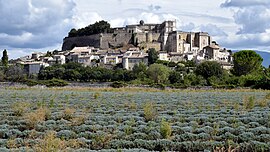Grignan
| Grignan | |
|---|---|

View of Grignan and its castle, with a lavender field in the foreground
|
|
| Coordinates: 44°25′13″N 4°54′32″E / 44.4203°N 4.9089°ECoordinates: 44°25′13″N 4°54′32″E / 44.4203°N 4.9089°E | |
| Country | France |
| Region | Auvergne-Rhône-Alpes |
| Department | Drôme |
| Arrondissement | Nyons |
| Canton | Grignan |
| Government | |
| • Mayor | Bruno Durieux |
| Area1 | 43.43 km2 (16.77 sq mi) |
| Population (2008)2 | 1,521 |
| • Density | 35/km2 (91/sq mi) |
| Time zone | CET (UTC+1) |
| • Summer (DST) | CEST (UTC+2) |
| INSEE/Postal code | 26146 / 26230 |
| Elevation | 130–471 m (427–1,545 ft) (avg. 198 m or 650 ft) |
|
1 French Land Register data, which excludes lakes, ponds, glaciers > 1 km² (0.386 sq mi or 247 acres) and river estuaries. 2Population without double counting: residents of multiple communes (e.g., students and military personnel) only counted once. |
|
1 French Land Register data, which excludes lakes, ponds, glaciers > 1 km² (0.386 sq mi or 247 acres) and river estuaries.
Grignan is a commune in the Drôme department in the Auvergne-Rhône-Alpes region in southeastern France.
It has a magnificent Renaissance castle and is mentioned in the letters that Madame de Sévigné wrote to her daughter, Madame de Grignan, in the 17th century.
Grignan is located in the south of the Drôme department, near the border of the neighbouring Vaucluse department, and close to Mont Ventoux, the highest mountain in Provence.
To visit Grignan, take the A7 autoroute and use either exit #18, Montélimar Sud, or #19, Bollène.
The main crops produced in the area are lavender, truffles, wheat, and sunflowers. Nearby is the village of Nyons, world famous for its olives.
Several archeological excavations have shown that the rocky promontory of Grignan has been occupied since the Iron Age. There is evidence of a former Bronze Age society here, as well as Roman occupation in the 5th and 6th centuries AD. Historians have noted that in the year 1035, a cartulaire (a ledger of church or monastery property titles) from the Abbey of Saint-Chaffre in the Haute-Loire, makes mention of an obscure castellum Gradignanum. Over the next century, the name steadily evolved to become the castrum Grainan (1105), then Graigna, Grazinam ... We know very little about the birth of the castle or those who built it. The existence of a certain Christophe de Grignan has been established some time around the year 1030, and in 1035, the cartulaire of Saint-Chaffre, speaks of a 'Rostaing du château de Grignan,' Rostagnus de castello Gradignano.
...
Wikipedia


